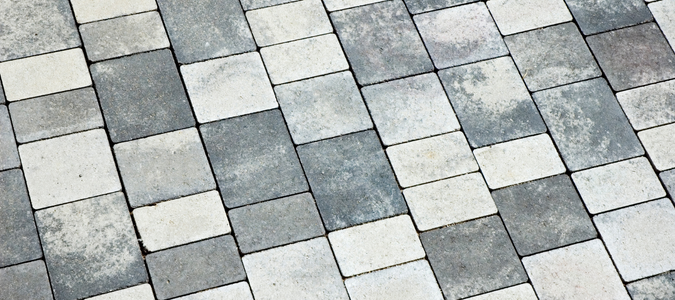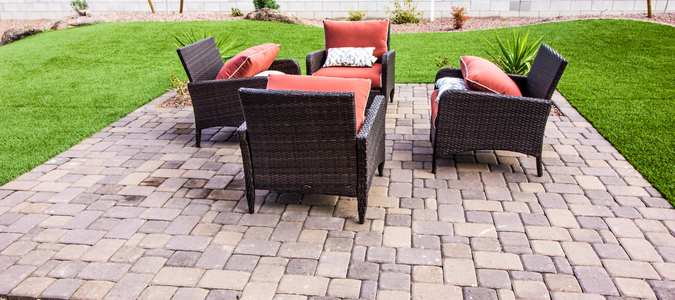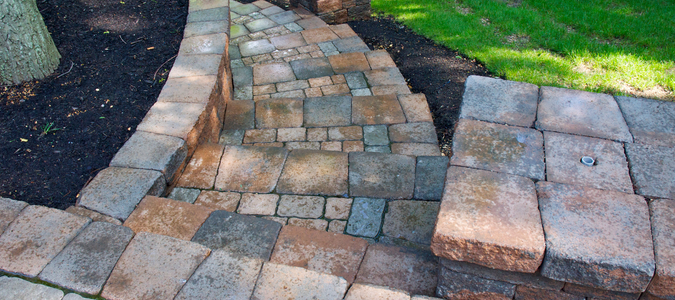As the seasons change, you might be looking to complete landscaping projects. One popular project is building a patio, perfect for spending time around a fire pit or lounging in patio chairs. There are a couple of ways that you can build a separate outdoor area for such activities, with either patio pavers or concrete as a base. But which one is better? Each one has its pros and cons.
Concrete Appearance
First, let’s look at concrete. You can get concrete in one of several ways: poured, in premade slabs or in prefabricated blocks that have the look of pavers. You can also choose different options for finishes, from smooth to lightly textured to a stamped concrete that looks like anything from pavers to stone to wood and has texture that provides traction. A landscaping professional can show you all your options and help you choose what is best for your space and for your lifestyle.
If you are considering making a patio around a pool as decking or pathways, you might want to look at prefabricated concrete. These slabs often come pre-stamped, and some interlock with almost invisible seams and install easily.
Paver Appearance
Pavers have a more appealing aesthetic, more options as far as design and their finish lasts longer. They can be made from bricks, stone, concrete or even porcelain. Their high amount of texture provides a better grip than concrete, especially when wet. The upfront cost of pavers can be 10 to 15 percent higher than that for concrete. However, that shouldn’t be the only consideration when making your patio construction decision. Costs will also vary when you consider the size of the space, the gradient, how much excavation is needed and whether you are building a new patio or replacing an existing one.
Durability
There is a difference between pavers and concrete in the amount of weight each material can handle. Pavers can take more weight compared to concrete, about four times as much. Concrete is also more likely to crack if the ground shifts or too much weight is on it. Be mindful that power washing can cause damage to concrete. Cold weather and expansion and contraction from moisture can also cause cracking. Cracks aren’t easy to fix on a concrete slab. If it’s more than a hairline crack, you are looking at having to tear up the entire slab and replace it with a new one. This can negate the initial savings of choosing concrete over pavers.
If any pavers somehow sustain damage, it’s as easy as replacing the damaged pavers. You don’t have to replace the entire patio! Pavers can last 50 to 100 years. Concrete only lasts about 25 to 30 years.
Pavers are less likely to crack because of their makeup. The natural density of stone keeps water out, reducing the chances of moisture causing damage. The sand joints and the natural interlocking between each set of pavers allow for plenty of expansion, so there is no cracking.
Maintenance
The same cracks that allow for expansion between pavers make cleaning a little troublesome. Getting the gunk out of a paver patio can take a little time, whereas a concrete slab can be washed off with a hose. On the other hand, concrete needs to be sealed to help keep stains at bay, with reapplication every year or two. Pavers do not need to be sealed to keep stains away.
With cracks in concrete and with pavers, you will need to watch out for weeds, which often grow in any little crevice they can find. Something that helps pavers repel the weeds is the polymer sand that is often used to help lock the pavers together. Talk to a landscape professional about your patio requirements to help determine which material is right for your project.
Repairs
If you need to fix something on top or underneath a paver patio, no problem. You can pull up the affected pavers, make the repairs and replace them. With a concrete slab patio, you would usually need to chip away broken parts and make an epoxy patch. In such cases, the concrete almost never looks the way it did before the break. For major breaks or to end up with a slab that looks like new, you would need to rip up the entire slab and install a new one.
How To Build a Paver Patio
Building a paver patio is a time- and labor-intensive process. While some handy homeowners can handle this big project, it is typically best left to the professionals. These are the steps your professional will take to build you the paver patio of your dreams.
The first step is to obtain any necessary permits. The next step is to determine the patio’s size. You want it to be big enough to fit all your patio furniture with space to walk around it all. A landscape design with something heavy like a grill or a hot tub will require thicker pavers than a design without such items. Next, consider where to put the patio. Consider how sight lines will look from your home’s windows and back door.
Plan the type of pattern you want for your patio. The two most common patterns to lay out are jack-on-jack, simply laying the pavers out in rows, and running bond, laying the pavers out in rows, slightly offset. You can also ask for a herringbone or pinwheel pattern for something a little fancier.
Getting a Professional’s Help
Your professional will then start marking your patio space with stakes and string. They will make sure the layout is square and level. The patio surface needs to slope properly, with a one-inch drop for every four feet of length.
Then, they will dig about six inches of dirt up all across the patio area. Rake the soil and then tamp it down, so it’s a solid base. Add two inches of base material or gravel, then wet and tamp down. They will repeat this process until there is a compacted thickness of base or gravel that is appropriate for the use of the area. Lay down landscape fabric to help with weed control and keep materials from mixing. Then, they will add one inch of builders sand on top of the fabric to set the pavers and smooth the sand with a long straight board.
Next, your professionals will place the pavers about one-eighth inch apart and tap them into place with a rubber mallet. They continue this process until all pavers have been set. Once all pavers are installed, they spread a light layer of sand across the top of the pavers and brush with a broom to get the sand down in the cracks. The job is finished with a hose to water down the sand and help it settle. Then, they hose down again to wash off the surface of the pavers, and it’s done done.
This is a time- and labor-intensive process. If you’re ready to install a paver patio, call a landscaping professional. They can help with the planning and execution of the perfect paver patio.
Polymeric Sand Versus Paver Sand
Polymeric sand is manmade, created by mixing fine sand and additives like silica. Landscapers use it to fill in joints between pavers, as do construction workers. Polymeric sand is very similar to regular sand before it is activated.
Adding water activates bonding agents that lock the paving stones in place. Adding polymeric sand is one of the final steps when installing a paver patio. The sand is also known as hardscape or jointing sand. Patio installers prefer polymeric sand to regular sand because it sticks to pavers better and keeps the joints between them even and durable.
Paver patios need sand to seal the pavers and make sure the structure is firmly in place and durable. Polymeric and regular sand are two types that are popular for patio projects. The one you use for your patio depends on the project and preference.
Regular sand is easy to find and convenient to use. The coarse particles form a lasting sealer for the joints between pavers. Regular sand distributes evenly and works well when you might need to tweak your patio design. You won’t need maintenance, and the cost of regular sand is less than that of polymeric sand. This type of sand has a longer life expectancy and is available in several shades that can match your patio design.
Polymeric sand manages drainage better than regular sand and prevents weed growth, like crabgrass, and insect infestation. Talk to a landscape professional about which sand best suits your patio project plans.
ABC Can Help With Your Paver and Concrete Landscaping Needs
There are many factors to consider when deciding what design to use and whether to use pavers or concrete. Then, planning out the design and actually executing it turns this into a large project. If you’re ready to upgrade your yard, contact ABC Home & Commercial Services. Our landscaping professionals can give you the upgrade you’ve been looking for. They can even help you with other landscaping tasks, like advising you on landscape tree lighting.



